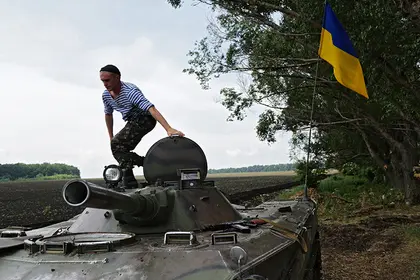A declaration of martial law would need to be
signed by President-elect Petro Poroshenko following his inauguration on June
7. He said after his election win on May 25 that he planned to end the conflict “in hours,
not months.” However, in a meeting with U.S. President Barack Obama in Poland
on June 4, he took a softer tone, saying that he would seek a peaceful
settlement to the conflict in the east.
Poroshenko’s press team declined to comment on
the president-elect’s intentions regarding martial law until after his inauguration, and Ukraine’s
National Security and Defense Council said it would discuss the option only
then.
JOIN US ON TELEGRAM
Follow our coverage of the war on the @Kyivpost_official.
On June 4, Ukrainian forces gave up a State Border
Guards Service base that had been under siege by heavily armed pro-Russia insurgents for nearly
two days and a National Guards base that was attacked near Luhansk. Several servicemen were wounded in the fights, and a handful of insurgents were killed. Following
the assaults, insurgents made out with dozens of weapons and at least one
armored personnel carrier.
Ukraine’s government and the West has blamed Russia for fomenting the unrest in the country’s eastern regions, while Moscow says it has nothing to do with the insurgency and has called on Kyiv to halt its military operations there.
Should Poroshenko decide to move forward with
the plan to introduce martial law, there will be little left for him to do
other than sign the declaration, since his predecessor has already laid the
groundwork for him.
“[Interim President] Oleksandr Turchynov ordered
the National Security and Defense Council Secretary, the Interior Ministry, the
Defense Ministry, head of the State Border Service and head of the SBU [Security
Services of Ukraine] by Friday, by tomorrow morning, to prepare their
proposals for introducing martial law in these regions,” acting Presidential
Chief of Staff Serhiy Pashynskiy told the Kyiv Post. “The law allows for the
introduction of martial law on concrete territories.”
Imposing martial law in Donetsk and Luhansk
oblasts, strongholds of the Kremlin-backed insurgents, would allow for Ukraine’s
government to close its eastern border and evacuate the local population before
ramping up its anti-terrorist operation.
Ukraine’s government would also be able to introduce
curfews, construct check points, place travel limitations on the population and
mobilize civilians for social work and cleanup operations. It can block television,
radio, internet and other channels of communication. It can also ration food
and drug supplies, confiscate private property and lodge soldiers in private
homes and other premises.
Perhaps most importantly, Pashynskiy said martial
law will help coordinate all agencies that are parties in the country’s
anti-terrorism operation, including the National Guard, the army, police,
secret service and border guard.
In a move highlighting further the government’s
intent on introducing martial law, a new draft law was filed in the Verkhovna
Rada, Ukraine’s parliament, to plug legal holes that regulate martial law,
according to Deputy Head of the President’s Administration Andriy Senchenko.
“If you look at the (overlapping) legal field regulating
the (actions of) the police and the army, there are loopholes formed. Nobody
can approve decisions clearly,” Senchenko said.
But Nestor Shufrych, a Party of Regions lawmaker,
expressed doubt that martial law and new laws to regulate the anti-terrorism
operation will help quell the conflict in eastern Ukraine.
“Today we see chaotic decisions that had not
been thought through strategically and tactically, which we take every day. How
much longer will we be approving anti-terrorism laws? We have been fighting
terrorism for two months, and see no results,” he said.
Shufrych said the government should take its
work in a different direction, “seeking compromise” with the separatist leaders in eastern Ukraine instead.
But indications are that the new president will
be taking a different approach. Victoria Siumar, deputy secretary of the
National Security and Defense Council, told the Kyiv Post that the council will
convene to discuss the introduction of martial law after the president’s
official inauguration on June 7.
The president officially presides over the council,
and its recommendation is the first legal step in introducing martial law. After
its recommendation, the president files it with parliament for a vote within
the next two days. The president indicates the term for which martial law will
be introduced, as well as geographical limits. In this case, it’s believed that
martial law would be imposed in the two embattled eastern regions of Donetsk
and Luhansk.
“This is a real war, and what we are doing is upgrading the legal status to match the reality,” Siumar said. “There is a decision to call things by their proper name.”
Kyiv Post editor Christopher J. Miller and
deputy chief editor Katya Gorchinskaya can be reached at miller@kyivpost.com and
gorchinskaya@kyivpost.com.
You can also highlight the text and press Ctrl + Enter




